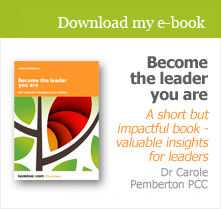The leader's profile

Three of my recent clients have struggled to establish and build their profiles at work. A technically skilled and experienced female COO in a high-profile, fast-paced organisation, functioning internationally, needed to make a sustained impact with a counterpart in another country. A leader in the field of talent wanted to take the next step in his career, and needed to make a positive impression on known and unknown stakeholders. A leader in financial services was frustrated at repeatedly being turned down for promotion.
Out there or understated? Loud or quiet?
There’s a common perception that the effective leader is the leader with an imposing presence, whether that’s a physical presence, the volume of their speech, the amount they speak or the apparent authoritativeness of what they say. It can be easy to assume that the expressive, obvious character in the room is also the most obvious leader.
The challenge of the profile
While extroverted men find it easy to make their presence felt (and indeed take it for granted), introverted people – and introverted women in particular – struggle more to be noticed and valued. Extroverts enjoy talking about their achievements and they’re comfortable being in the limelight, including speaking in front of groups. They enjoy being seen and find self-promotion easy. In contrast, introverts are more likely to make much less of their gifts and talents, and are far less comfortable in the glare of the public gaze, so it can be challenging for them to build a public profile.
Introverts have a particular challenge when they need to raise their profiles within and outside their organisations, especially when it comes to developing their careers and strengthening their network connections of stakeholders.
Start with meetings
Introverts – who are energised by their internal lives rather than engaging with the outside world – can find connecting with other people in meetings tiring and costly in terms of energy. There are some simple strategies they can adopt to connect with others and establish themselves with more impact: looking at people, making eye contact and smiling, for example, can go a long way. So too can actually saying something – although that might be the most challenging aspect of meetings: finding a way to intervene in the cacophony of comments and opinions. It’s worth remembering that, as natural reflectors, the few well-thought-out things they have to say might have at least as much, if not more, impact than the many things that an extrovert has to say: extroverts often work out their ideas and what they mean while they’re speaking, which can be confusing for their listeners.
Relationships
As challenging as it might be for the introvert to interact with extroverts, it can be both enjoyable and fruitful for both of them to seek out one-to-one interactions with people who are significant stakeholders. This can be as casual as having a coffee together, it might be the offer of an idea, or it might be reflection at the water cooler on a shared topic of interest. And it all comes under the umbrella of raising your profile.
Profile by highlighting achievements
Sharing news of an achievement, and its impact for a team, a department or even an organisation can inspire and benefit others, besides building the individual profile: thinking of it as of benefit to the community can defuse the uncomfortable spotlight that it brings, and introverts can do well to allow their achievement more exposure by sharing it on whatever platforms their context offers – Intranet, newsletters and external events, for instance.
Fascinatingly, introverts are often comfortable ‘performing’ alone on stage (actual or metaphorical) than one might expect. A case in point is Brene Brown, originator of important – and highly impactful – signature work on vulnerability and humility at work.
Beyond the practical tips: just be
There are endless practical tips on raising profile. However, this ignores an important – and arguably more powerful – area that’s separate from the practical tips: how to ‘just be’. To find comfort and safety in the authenticity, ease and truth of being yourself without trying to match anyone else, and without trying to match the imagined expectations or assumptions of other people. That comfort with being yourself – being happy in your own skin – conveys natural confidence and gravitas (see my blog on gravitas) and can have more impact, and raise profile more effectively, than any number of learnt techniques. And for an individual to reach that state will be more or less challenging, depending on the condition of their self-perception, their self-belief, their self-esteem and their self-awareness. It might be hard work, but it can be appropriately addressed in coaching, and can be immensely and sustainably rewarding.
Photo by Clem Onojeghuo on Unsplash


